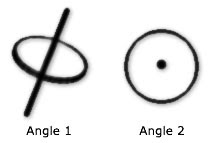To answer this, let's first take a look at our world. We can take a piece of paper and draw any 2d shape we want, as wide and tall as we want, as long as we have a big enough canvas. But when it comes to writing, what we really want is something small - simple symbols that can be written as fast as possible and are around the same size, distributed on an organized fashion across the canvas (left to right, up to down, etc...). Also, these symbols must be read in sequence to form a full sentence.
In a 4d world, things are not so different. Surely, a 4d entity can easily draw a 3d cube, and even paint anywhere inside this cube. But there are much simpler shapes they can draw. A very simple symbol in our world would be a line. When we draw a line, we can see all the points that form that line, and even rotate our canvas to look at it from another angle. In 4d, the equivalent of drawing a line would be drawing a single 3d "stick" - like a small wire. A 4d entity would then be able to see all the points outside and inside that "stick". Notice that this symbol would have to have some thickness for it to be noticed by a 4d entity.
The 4d canvas can be rotated in a similar fashion to our 3d canvas. If the 4d canvas is upside down, all the symbols projected on the 3d FOV will appear upside down. If the canvas is rotated across the 4th dimension, the symbols currently on the FOV will slightly distort or disappear completely. Also, 4d entities can only "focus" at a small point (or rather a small sphere) of the 3d FOV. That means they can only focus on a few symbols at a time, and only if these symbols are small enough, similar to the way we read.
The picture below compares our canvas with a 4d canvas:
 |
As you can see, a single "page" of writing in our world is equal to a single "line" of text in the 4d world. Notice that the symbols used in the 4d canvas might require 3 dimensions. After all, it is just as easy for them to write horizontally as it is to write "forward". The picture also illustrate the issue of the distance between lines. In the 4d world, not only the "lines" can be spaced in different lenghts vertically, but also forwardly.

|
The answer appears to be simple: several 4d "pages" (4d canvas, very close to a 3d cube with little 4d depth) that are hold toghether. But some analysis is necessary to imagine how would they write on the back of the pages, and how are these 3d objects holded together. The first question is actually easy, and if you can understand the tesseract rotations, you probably already know the answer. Reading the front of the page would be just as described above (a 3d cube). Then, a simple rotation across the 4d axis would bring forth a different cube, with different content. Since this page would have just a small depth, at some point in the rotation the page will look like a simple flattened 3d cube (or a square), and at this point no content will be visible (only at 2 particular angles a perfect cube is visible with all the content). While reading on a 4d canvas, the cube that is on the "back" is inversed, which means that the content is flipped horizontally (much like in our world). Notice that the content will still remain distributed equally both vertically and forwardly, so a more trained 4d eye can still read it easily if the page allows seeing through it.
As for the second question, imagine a projected tesseract in the 3d FOV. Now imagine that, across the 4th dimension, the tesseract is being cut into small "slices", and each slice is equal to a very small (in the 4d axis) 4d object bounded by 3d cubes. But instead of cutting out 3d crossections of the size of each cube, a small portion of each crossection is being kept, thus linking the 4d objects toghether. Imagine, now, that a 4d entity is looking at the "cover" of a 4d book: it will look like a 3d cube (in the 3d FOV). When the 4d entity "flips" the cover, the 3d cube starts to flatten, and the next 3d cube will start to appear on the same space that was being occupied by the cover (in the 3d FOV).
As the cover flattens itself into a square, it "moves" to one of the sides of the new 3d cube. After being flattened, it starts to expand into a cube again, but now to a different side. After the cover is entirelly flipped, it will occupy a new 3d space, right next to the other 3d cube, but now it will be reversed, and the content will be different. In this moment, two 3d cubes will be visible in the 3d FOV, and they will appear to be glued together.
To conclude the visualization of the 4d book, imagine only the cover again, but right to its "left", another 3d shape will be visible. This shape represents the portion of the book that holds the pages together (the method used varies from book to book, but for this example, imagine an ordinary hardcover book). In this case, the same thing described above will occur, but after the cover is entirelly flattened, and as it starts to expand again, it will start to occupy the 3d space of the FOV that is being currently filled with this portion of the book. After a while, the volume of the 3d projection of the cover will be much bigger than the volume of the projection of the mentioned portion.
0 comments:
Post a Comment